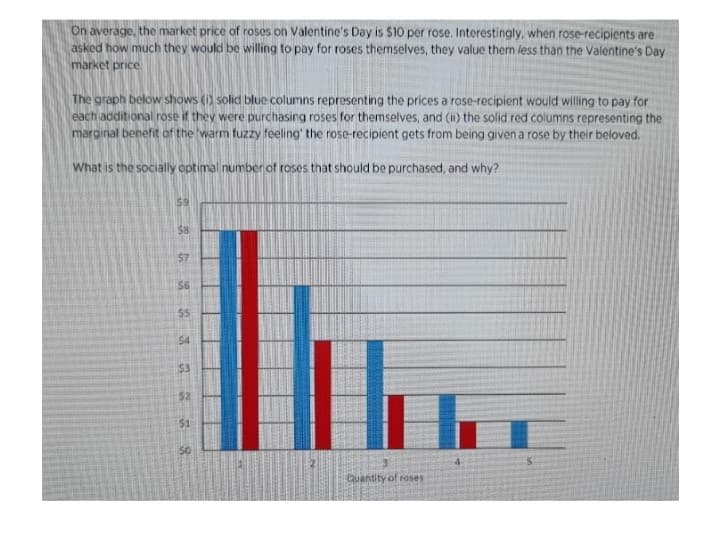On average, the market price of roses on Valentine's Day is $10 per rose. Interestingly, when rose-recipients are asked how much they would be willing to pay for roses themselves, they value them less than the Valentine's Day market price. The graph below shows() solid blue columns representing the prices a rose-recipient would willing to pay for each additional rose if they were purchasing roses for themselves, and (ii) the solid red columns representing the marginal benefit of the warm fuzzy feeling the rose-recipient gets from being given a rose by their beloved. What is the socially optimal number of roses that should be purchased, and why? 9 00 4 $6 $5 $4 $3 $1 Quantity of roses
On average, the market price of roses on Valentine's Day is $10 per rose. Interestingly, when rose-recipients are asked how much they would be willing to pay for roses themselves, they value them less than the Valentine's Day market price. The graph below shows() solid blue columns representing the prices a rose-recipient would willing to pay for each additional rose if they were purchasing roses for themselves, and (ii) the solid red columns representing the marginal benefit of the warm fuzzy feeling the rose-recipient gets from being given a rose by their beloved. What is the socially optimal number of roses that should be purchased, and why? 9 00 4 $6 $5 $4 $3 $1 Quantity of roses
Chapter6: Demand Relationships Among Goods
Section: Chapter Questions
Problem 6.9P
Related questions
Question
M10

Transcribed Image Text:On average, the market price of roses on Valentine's Day is $10 per rose. Interestingly, when rose-recipients are
asked how much they would be willing to pay for roses themselves, they value them less than the Valentine's Day
market price.
The graph below shows (i) solid blue columns representing the prices a rose-recipient would willing to pay for
each additional rose if they were purchasing roses for themselves, and (ii) the solid red columns representing the
marginal benefit of the warm fuzzy feeling the rose-recipient gets from being given a rose by their beloved.
What is the socially optimal number of roses that should be purchased, and why?
00
4
$6
$5
$4
$3
$2
$1
50
Quantity of roses
Expert Solution
This question has been solved!
Explore an expertly crafted, step-by-step solution for a thorough understanding of key concepts.
Step by step
Solved in 2 steps

Knowledge Booster
Learn more about
Need a deep-dive on the concept behind this application? Look no further. Learn more about this topic, economics and related others by exploring similar questions and additional content below.Recommended textbooks for you


Exploring Economics
Economics
ISBN:
9781544336329
Author:
Robert L. Sexton
Publisher:
SAGE Publications, Inc

Microeconomics: Principles & Policy
Economics
ISBN:
9781337794992
Author:
William J. Baumol, Alan S. Blinder, John L. Solow
Publisher:
Cengage Learning


Exploring Economics
Economics
ISBN:
9781544336329
Author:
Robert L. Sexton
Publisher:
SAGE Publications, Inc

Microeconomics: Principles & Policy
Economics
ISBN:
9781337794992
Author:
William J. Baumol, Alan S. Blinder, John L. Solow
Publisher:
Cengage Learning